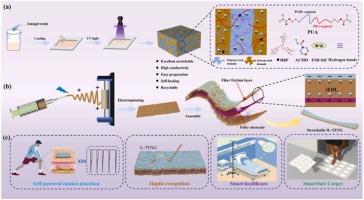采用双电层和自适应离子液体在全离子凝胶纤维基TENG中史无前例地提高了输出和动态稳定性
IF 17.1
1区 材料科学
Q1 CHEMISTRY, PHYSICAL
引用次数: 0
摘要
摩擦电纳米发电机(TENG)由于其自供电的功能,在可穿戴电子领域引起了相当大的研究兴趣。然而,开发同时结合轻量化、灵活性、稳定性和高输出性能的TENG仍然具有挑战性。本文首次利用静电纺丝技术制备了一种集摩擦层和电极于一体的全离子凝胶纤维基单电极TENG (IL-TENG)。首先,离子凝胶由超支化聚合物交联的聚氨酯网络和离子液体组成。聚氨酯网络包含聚碳酸酯二醇(PCDL)段作为离子液体中的低溶剂区域,聚乙二醇(PEG)段作为高溶剂区域。相分离与柔性交联剂的结合巧妙地解决了电离胶的机械强度与高导电性之间的矛盾,同时增强了其相容性和稳定性。其次,加入中等导电性的离子凝胶纤维膜作为中间层,作为离子电双层(iEDL),有效地减少了摩擦过程中的电荷耗散。这一创新使IL-TENG的输出性能提高了4倍。此外,高导电性离子凝胶纤维膜电极的集成,结合离子凝胶可调的力学性能,显著提高了IL-TENG在动态条件下的拉伸性能和运行稳定性。IL-TENG的输出功率密度达到27mw /m²,并在5000次循环中保持出色的循环稳定性。作为一种可穿戴的自供电传感器,IL-TENG在高级应用方面具有巨大的潜力,包括人体运动检测、手写识别、实时医疗反馈和用于监控家庭入侵的智能地毯。该研究为下一代健康监测和人机交互奠定了基础。本文章由计算机程序翻译,如有差异,请以英文原文为准。

An unprecedented strategy with electric double layer and adaptive ionic liquid in fully ionogel fiber-based TENG for enhanced output and dynamic stability
The triboelectric nanogenerator (TENG) has attracted considerable research interest in wearable electronics due to its self-powered functionality. However, developing a TENG simultaneously combining lightweight, flexibility, stability and high output performance remains challenging. Herein, a fully ionogel fiber-based single-electrode TENG (IL-TENG), integrating both the friction layer and electrodes, was fabricated for the first time by using the electrospinning technology. Firstly, the ionogels are composed of a polyurethane network crosslinked by hyperbranched polymers and an ionic liquid. The polyurethane network contains polycarbonate diol (PCDL) segments acting as low-solvent regions in the ionic liquid, and polyethylene glycol (PEG) segments acting as high-solvent regions. The combination of phase separation and flexible crosslinkers ingeniously resolves the contradiction between the mechanical strength and high electrical conductivity of the ionogels, and simultaneously enhances their compatibility and stability. Secondly, the incorporation of a moderately conductive ionogel fiber membrane as an intermediate layer, functioning as an ionic electric double layer (iEDL), effectively reduces charge dissipation during friction. This innovation enhances the output performance of IL-TENG by 4 times. Furthermore, the integration of highly conductive ionogel fiber membrane electrodes, combined with the tunable mechanical properties of the ionogel, significantly improves the tensile performance and operational stability of IL-TENG under dynamic conditions. The IL-TENG demonstrates an impressive output power density of 27 mW/m² and maintains outstanding cyclic stability across 5000 cycles. As a wearable, self-powered sensor, the IL-TENG offers significant potential for advanced applications, including human motion detection, handwriting recognition, real-time medical feedback and smart carpet for monitoring home intrusion. This research lays a foundation for next-generation health monitoring and human-computer interaction.
求助全文
通过发布文献求助,成功后即可免费获取论文全文。
去求助
来源期刊

Nano Energy
CHEMISTRY, PHYSICAL-NANOSCIENCE & NANOTECHNOLOGY
CiteScore
30.30
自引率
7.40%
发文量
1207
审稿时长
23 days
期刊介绍:
Nano Energy is a multidisciplinary, rapid-publication forum of original peer-reviewed contributions on the science and engineering of nanomaterials and nanodevices used in all forms of energy harvesting, conversion, storage, utilization and policy. Through its mixture of articles, reviews, communications, research news, and information on key developments, Nano Energy provides a comprehensive coverage of this exciting and dynamic field which joins nanoscience and nanotechnology with energy science. The journal is relevant to all those who are interested in nanomaterials solutions to the energy problem.
Nano Energy publishes original experimental and theoretical research on all aspects of energy-related research which utilizes nanomaterials and nanotechnology. Manuscripts of four types are considered: review articles which inform readers of the latest research and advances in energy science; rapid communications which feature exciting research breakthroughs in the field; full-length articles which report comprehensive research developments; and news and opinions which comment on topical issues or express views on the developments in related fields.
 求助内容:
求助内容: 应助结果提醒方式:
应助结果提醒方式:


